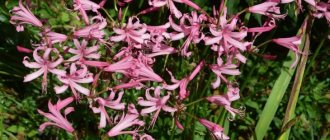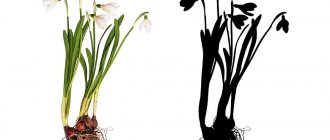Author: Natalya Category: Garden plants Published: January 09, 2019Republished: February 09, 2019Last edits: November 03, 2020
- When to plant
- Growing conditions
- Autumn work
- Stemless primrose, or common primrose (Primula vulgaris)
plant (lat. Primula vulgaris) , or common primrose , is a herbaceous perennial from the genus Primrose. Under natural conditions, primrose grows in Europe, northern Africa, the Middle East and Central Asia. Primrose has been known since time immemorial - the ancient Greeks considered it the medicinal flower of Olympus and called it “dodecatheon” - the flower of the twelve gods. Primrose is one of the first spring flowers; people call it “rams” or “keys”. The Old Norse saga tells that primrose flowers are the keys of the fertility goddess Freya, with which she opens spring. And the Germans believe that primrose is the key to marriage. The Celts and Gauls included primrose in their love potion. There is a Danish legend that an elven princess who fell in love with a mortal became a primrose, and the ancient Greeks came up with a myth in which, out of compassion, the gods turned the body of the young man Paralysos, who died of love, into a fragrant primrose, and now this flower cures all ailments, including and for paralysis - it is not without reason that in folk medicine the flower is called a paralysis herb. The cultivation of primrose in Europe began in the 16th century; it has always been a popular flower in England - in this country there are several clubs for lovers of primrose auricula. Sometimes the addiction weakened, but then it was revived with renewed vigor. Currently, primrose exhibitions are held annually in England, and every time there is something to see - the blooming primrose is an amazing sight.
Planting and caring for primrose
- Planting: sowing personally collected seeds into boxes dug into the ground - immediately after collection. Sowing purchased seeds for seedlings - in early February, transplanting seedlings into open ground - at the end of May after two years or in the fall in the second year of life.
- Flowering: spring or summer - depending on the type and variety.
- Lighting: depending on the type and variety - in bright sun or in the shade of trees and shrubs.
- Soil: moist, loose, light, moisture-absorbing nutrient soil.
- Watering: the soil in the flowerbed should be slightly moist at all times. In hot weather you will have to water more often. Water consumption – 3 liters per m² of area.
- Feeding: mineral fertilizers with a reduced nitrogen component in half the dosage specified by the manufacturers weekly from the moment the leaves appear until the end of flowering.
- Reproduction: seeds, leaf cuttings and dividing the bush.
- Pests: beetles and slugs.
- Diseases: bacterial spot, anthracnose, jaundice, rust, powdery mildew, cucumber mosaic virus, stem and root collar rot.
Read more about growing primrose below.
Caring for a garden perennial plant
When and how is it necessary?
Transplanting or planting primrose can be done in the fall . When is it better to transplant or plant primrose? Transplantation in open ground is done only in the second year of the plant’s life. After flowering is complete, the primrose is considered ready for the transplant process:
- To prepare the plant for transplanting, you need to water the soil a day before the event.
- Remove the plant along with the earthen lump and carefully transfer it to a new hole.
- Carefully fill the voids with soil and compact the soil around the plant a little.
- Water with a small amount of water.
Main Feature
When it comes to autumn transplanting to another place or planting in open ground, it is important to calculate so that there is enough time for the plant to take root before the onset of low temperatures before planting.
In autumn, primroses require special care:
The natural habits of the plant encourage it to grow leaf mass after the flowering period, which will serve as protection during cold weather. Therefore, it is important to maintain the rosette until the very end of autumn.- Watering is done moderately, keeping the soil slightly moist.
- Primulas are frost-resistant and heat-loving. Frost-resistant varieties are covered and prepared in a special way for winter, and heat-loving varieties are stored in a cool room until spring.
Therefore, a particularly important part is to carefully study the information about the varietal qualities of primrose.
Botanical description
The genus Primrose is one of the most numerous in the world flora; according to various sources, it numbers from 400 to 550 species, but plants of this genus are still found in nature, not described by scientists. 33 species grow in Europe, 2 in North America, one species on the island of Java, several in South America and Africa, and the remaining three hundred-plus species of primrose grow in Asia, Western China and the Himalayas. Primrose chooses damp places - in meadows, along the banks of streams and mountain rivers.
The underground part of the primrose is a rhizome with roots. The basal leaf rosette consists of dissected or simple, sessile or petiolate oblong oval lanceolate leaves. In some species the leaves are wrinkled, in others they are leathery, dense, grayish-green in color, as if covered with wax. Primrose flowers on long leafless peduncles are single or collected in pyramidal, spherical, cushion-shaped, tiered, bell-shaped or umbrella-shaped inflorescences. They have a tubular shape with a bend - flat or funnel-shaped. The primrose fruit is a cylindrical or spherical polysperm.
Perennial and annual garden primrose is grown in culture; primrose is also cultivated at home.
- Yaskolka: growing and care in the garden
Possible diseases and treatment
Primrose is a plant that is very resistant to various pests and infections. But she is very vulnerable during the transplant and post-transplant period. During this period, the plant may be subject to the following attacks:
In addition, primrose may experience fungal infections:
- Cercosporella;
- ramularia;
- bacterial spot.
Diseases affect both young leaves and old ones. The fact is that during the rooting period after transplantation, the plant’s immunity is greatly weakened, and it cannot cope with diseases and pests on its own - the primrose needs to be helped by treating it with fungicides.
You can spray the plant with copper oxychloride or Bordeaux mixture. You should also not forget that late blight, a parasitic fungus that can kill the plant, may appear on the crop - in this situation, reduce watering. Slugs, aphids, weevils, nematodes, mites and flea beetles can also greatly annoy young plants, so treatment with such drugs as:
Complex fertilizers are applied to the soil, which should contain (per 1 square meter 10-20 grams):
In addition, it is worth removing dried leaves, which will interfere with the application of fertilizers, and the soil under the bushes must be well loosened so that there is air access to the roots.
Repeated feeding is carried out 12-15 days after the primrose blooms. Organic fertilizer is used, which is diluted in proportions of 1:10, 0.5 liters of solution is poured under one flower. This will help the plant set flower buds for next year.
Pruning is a necessary and important procedure that is not recommended to be neglected. Should the plant be pruned in the fall? This procedure must be done at a certain time, and it is better in the spring, as soon as the snow melts and the severe frosts stop. This will stimulate the plant to grow and bloom again.
We talked in detail about caring for primrose outdoors and at home here.
Growing primrose from seeds
How to sow seeds
Primrose seeds lose their viability very quickly, so it is best to sow the seeds immediately after collecting them in boxes placed in the ground. If you bought high-quality seeds and do not want to risk them, then planting primrose seeds for seedlings is carried out in early February on the surface of a substrate consisting of two parts of leaf soil, one part of sand and one part of turf soil. There should be no more than 5 seeds per 1 cm² of substrate, which are not buried, but simply pressed to the surface. The container with the crops is placed in a plastic bag and placed in the freezer for 3-4 weeks at a temperature no higher than -10 ºC.
After a month, the frozen crops are transferred in bags to the windowsill, shaded from direct rays, and wait for germination, keeping the soil slightly moist. The optimal temperature for seed germination is 16-18 ºC. Not all types of primroses need stratification - for example, common primrose and fine-toothed primrose germinate without freezing. When seedlings begin to appear, and primrose seeds are usually in no hurry to germinate, the bags are gradually opened slightly, accustoming the seedlings to the air, and after two weeks the bags are removed completely.
Seedling care
Primrose seedlings grow very slowly. After the appearance of two or three true leaves, the seedlings are dived into boxes using tweezers and continue to care for them, moistening the soil as necessary. You need to pick up seedlings every time they grow strongly. Primrose is grown from seeds before planting in open ground for two years.
Features of planting a perennial plant
It is worth remembering that to decorate the site you need to plant the plant correctly; how to do this is the answer below.
Reference. The distance between small bushes should be at least 25 cm, and for large plants - 45 cm, otherwise, as the bushes grow, they will interfere with each other.
You can plant primrose in different ways, but let’s look at when to do it and how to do it using the most common methods.
Seeds
Most gardeners prefer to propagate the plant by seeds. Sowing can be done 3 times per season.
Gardeners generally prefer to plant primrose in this way. The nuance is that it differs in technology, since this can be done 3 times per season, while the sowing technology differs:
- Planting in spring. It is worth remembering that primrose seeds lose their viability very quickly, so for spring planting in the garden you need to use seeds purchased in the store.
But before planting the plant in open ground, you need to prepare the seeds. A month before planting, you need to pour a special soil mixture into a container and scatter the seeds over it. You don’t need to sprinkle them, just press them a little into the soil. Not all varieties of primrose need stratification, so before you start preparing seeds for sowing, you should clarify whether it is worth applying long-term preparation to a particular variety. - Sowing in autumn is the most popular technology among gardeners.
If you use this planting method, the plants will delight you with flowers for the next season. The only rule when planting in the fall is to cover the soil in which the seeds are sown to prevent freezing. Interesting! As soon as the snow begins to melt and the plant will be provided with a sufficient amount of moisture, which is very good for young sprouts. At the same time, in early spring there are no burning rays of the sun that can harm young leaves. - Sowing seedlings at home at the end of January, beginning of February. This method is more labor-intensive, as it requires careful preparation of the seed, so it is used only in exceptional cases.
It is worth noting that if it is not possible to sow primrose yourself, you can buy ready-made seedlings and propagate plants using simpler methods.
From the video you will learn how to plant primrose seeds:
Cuttings into the ground
This method of propagating a plant is very simple; let’s look at how to plant a cutting correctly:
Carefully separate the part of the shoot at the neck of the root so that there is a bud and a leaf on it. In this case, the sheet plate must be cut in half.
- Prepare the soil by mixing sand and humus in equal quantities.
- Plant the cuttings in the prepared composition.
- For rooting, you need to create optimal conditions for the plant:
- temperature – +17 degrees;
- bright lighting without direct sunlight;
- the soil is moderately moist.
When the third leaf appears, the primrose is transplanted into a small pot, the diameter of which should not be more than 10 cm. The plant is planted in the garden with the onset of warm weather in an open area.
From the video you will learn how to divide primroses in the fall:
Planting primrose
When to plant
Planting perennial primrose in open ground is carried out in spring or autumn in the second year of life. If you decide to plant primrose in the spring, then do it at the end of May. Primrose grows best in open ground in the shade of garden trees and shrubs, where direct sunlight does not penetrate. Only alpine species of primrose in the northern regions are planted in open sun. The soil for primrose is preferably moisture-absorbing, loose, light and well-drained, in which moisture will not stagnate for a long time.
Primrose grows well in clay soil. Too heavy clay soil can be made lighter by adding a bucket of sand, 2 kg of manure, vermiculite and chopped sphagnum moss per 1 m² of digging area.
How to plant
Small types of primrose are planted at a distance of 10-15 cm from each other, and large ones - at 20-30 cm. When planting, keep in mind that primrose does not like open spaces, so plant the seedlings in such a way that when the plants grow, the plantings will be closed. Primrose blooms from seeds in the second or third year of life.
How to care for crops
Typically, containers with crops are kept on window sills. In winter, it is ideal to grow primrose seedlings in well-lit windows. But direct sunlight should not fall on the microgreenhouse. However, in winter there are not often sunny days, and the sun is not as bright as in spring and summer. As long as there are no green shoots on the soil surface, direct sunlight is not a big problem. As soon as the seedlings appear, shading from the bright sun is a must!
As soon as the seeds begin to germinate, we begin to carefully monitor the humidity on the surface of the soil: it should not dry out, but it should not be too wet. Sometimes, in order to create sufficient moisture for the crops, it is necessary to treat the inside surface of the transparent cover with water from a sprinkler. Watering should be done very carefully and moderately while the seedlings are small. As soon as they begin to grow, you need to water abundantly only as needed. Typically, gardeners use a sprinkler with a very fine spray of water for watering or water the seedlings from a syringe without a needle.
After the emergence of seedlings, you need to constantly open and ventilate the crops and make sure that the soil is moist, but not wet! Otherwise, the seedlings will rot instantly. You need to completely remove the transparent cover or film when the seedlings have 1-2 true leaves. And you need to remove the cover gradually. If mold appears on the surface, then dust the soil with ordinary river sand (well washed and disinfected). You can buy it in flower shops or prepare it yourself.
You can also fight mold with a solution of Maxim or Vitaros by carefully treating the surface of the soil with a syringe. Make sure that after treating with fungicide the soil in the bowl is not too wet.
Caring for primrose in the garden
Growing conditions
Planting and caring for primrose in open ground usually occurs without any difficulties. How to care for primrose planted in open ground? Keep the soil in your primrose flower bed slightly moist, loose and clean - after weekly heavy watering, be sure to loosen the soil and remove weeds. In hot weather, the frequency of watering will have to be doubled. Water consumption in one session is approximately three liters per m².
Caring for perennial primrose involves frequent feeding of the flower with a weak solution of complex mineral fertilizers - the concentration should be half as much as the instructions provide, and the frequency of application should be weekly from the moment the first leaves appear until the end of flowering. However, you should not overuse the nitrogen component of complex fertilizers, because next year you will expect flowers, but will only see lush greenery. To prevent this from happening, apply only phosphorus and potassium fertilizers every other time.
Transfer
Caring for and growing primrose involves replanting the plant simultaneously with dividing the bush every 4-5 years, since primrose tends to grow strongly. Read about how and when to replant primrose in the next section.
Reproduction
, bush division and leaf cuttings are used to propagate primrose In the fourth or fifth year, in August or the first half of September, the overgrown primrose bushes are watered, dug up, the soil is shaken off from their roots, then the roots are washed in a bucket, the plant is divided into several parts with a knife with at least one renewal point on each, the sections are sprinkled with ash and then the cuttings are planted in a new place. After planting, the primrose is watered. Dividing the bush not only rejuvenates the plant, but also provides free planting material in which you can be completely confident.
If a plant has a weak root system or only one rosette, then it is propagated by axillary shoots. The primrose leaf with the petiole, bud and part of the shoot is separated and planted in the soil mixture, having previously cut the leaf blade in half. Keep the cuttings in a bright place, but protected from direct sunlight, at a temperature of 16-18 ºC in a moderately moist substrate. When the buds produce shoots with three to four leaves, they are planted in pots with a diameter of 7-9 cm, and in the spring they are transferred to open ground.
Pests and diseases
Primrose in the garden is affected by root collar and stem rot, jaundice, bacterial spot, rust, anthracnose, powdery mildew and cucumber mosaic virus. As soon as you notice modified leaves, destroy them immediately.
Among the pests that pose a danger to the plant are various nematodes and aphids, spider mites and weevils, as well as beetles, slugs and fleas. It is better to combat diseases by treating primrose in the spring with a two percent solution of Topsin or Fundazol, one percent Bordeaux mixture or copper oxychloride, and in the fall, preventive treatment with a one percent solution of Nitrafen is advisable. Beetles and slugs will have to be collected by hand, mites are destroyed by treatment with Actellik, and nematodes are killed by Ragor.
- Buzulnik: planting and care, types and varieties
What to do in the fall?
Primulas are not as afraid of low temperatures as temperature changes and rotting of roots. Changes, as a rule, occur from the difference in day and night temperatures, as well as from alternating thaws and sudden cold snaps. Hypothermia primrose in winter if the standards are not followed or rotting from excess moisture can lead to loss of germination.
The intense spring sun is also dangerous; it can burn primroses that have not yet adapted after hibernation. The best protection from the cold and a guarantor of climatic stability in the root zone is, of course, snow, but it is not always enough to provide the required degree of protection.
Therefore, in addition to temperature changes and cold weather, they create a shelter from soil with humus and a layer of spruce branches on top. When the snow cover is very thick, there is a threat of overheating.
To prevent rotting during the winter, holes are periodically punched in the snow cover using a pitchfork to create air access to the plant. When the melting begins in the spring, due to the same risk of the plant rotting, you need to partially clean the frozen crust of the crust.
Many varieties have frost-resistant properties and can easily winter without special insulation-shelter , but there are hybrid species that are not at all predisposed to wintering in open ground. During periods of low temperatures, they are removed from the soil and sent for storage in containers in rooms with special conditions.
Do I need to trim the leaves?
Is this flower pruned for winter? If phloxes and peonies are deprived of their aerial parts for the winter, then doing this with primrose is strictly prohibited. After flowering, the primrose rosette often fades and does not create the most aesthetic appearance, but the foliage is not cut off, since for the primrose it is a natural shield from winds and low temperatures during cold weather.
Advice! Dry foliage is removed only in the spring, when the snow cover melts and the plant is opened.
More information about transplanting and caring for primrose in the fall can be found here, and from this article you will learn how to plant the plant correctly.
Perennial primrose after flowering
Autumn work
After the primrose has bloomed, loosen the soil in the area, clear it of weeds and leave the primrose alone until winter - at this time its leaves begin to grow. It is very important that the leaf rosette is preserved until late autumn, since it will serve as a natural shelter for the plant. If you cut off the leaves in the fall, the primrose will begin to shrink, its flowering will weaken, and it will lose its decorative effect. But when spring begins, it is better to remove old, overwintered primrose leaves.
Garden primrose in winter
In areas with cold winters, primroses require covering with dry leaves, straw or spruce branches, and the covering layer should be at least 7-10 cm. There are types of primrose that do not need shelter, for example, Julia's primrose. In areas with warm, snowy winters, primrose does not need to be covered - snow cover will be enough. However, with the onset of spring, watch how the snow melts - the primrose should not dry out under the ice crust. Break the crust and let the water drain freely.
Types and varieties
As already mentioned, there are so many primroses in nature that botanists had to divide them into 30 sections. There are also plenty of species, varieties and hybrids in culture. They can be described endlessly. We will introduce you to the most common cultivated species and their most popular varieties.
Stemless primrose, or common primrose (Primula vulgaris)
In nature, it grows in Southern and Central Europe on the edges of forests, in alpine meadows near melting snow. This species has a short rhizome with thick cord-like roots. Lanceolate leaves up to 6 cm wide and up to 25 cm long are partially preserved during the winter. Light yellow or white with a purple throat, single flowers open on short peduncles 6 to 20 cm high, their wide petals are divided into two lobes.
Despite the fact that it was called ordinary, the stemless primrose is very beautiful and during flowering its bush looks like a bouquet. Flowering can begin in March, sometimes this species blooms again in September. In culture since the 16th century. Varieties:
- Virginia - white flowers with a pale yellow throat;
- Giga White - white primrose;
- Cerulea - blue flowers with a yellow throat.
Primula elatior
Grows in the Carpathians, in the middle and southern parts of Western Europe. This is a perennial with wrinkled oval leaves, finely toothed along the edges, from 5 to 20 cm long and 2 to 7 cm wide, which sharply taper towards the petiole. On the upper side of the leaf the veins are depressed, and on the lower side they protrude. Light yellow with a bright yellow spot at the base of the petals, fragrant flowers up to 2 cm in diameter are collected in umbrella-shaped inflorescences of 5-15 pieces. The barely pubescent peduncle reaches a height of 10 to 35 cm.
High primrose blooms profusely from April for 50-60 days. There are hybrids with larger flowers of lilac, white, cream, red, yellow - plain, with an eye or bordered. Varieties:
- Duplex - cherry flowers up to 2.5 cm in diameter with a dark yellow throat;
- Rosea - dark pink flowers with a yellow eye;
- Gelle Farben - light purple flowers with a diameter of 3.5 cm with a yellow throat;
- Goldgrand - brown flowers with a golden border and a yellow throat, diameter 2.5 cm.
There are groups of hybrids based on tall primrose with large flowers and long peduncles, attractive for growing as cut flowers. Among them are terry primrose Curiosity of a yellow-brown hue, Golden Dream of a bright yellow color, and Olga Menden with flowers of a light red hue.
Siebold's Primula (Primula sieboldii)
It blooms in June with lilac and pink flowers of different shades, collected in loose umbrella-shaped inflorescences. After flowering, the leaves of this ephemeroid die off.
Spring primrose (Primula veris)
Which is often called primrose officinalis, a representative of the European flora. It has wrinkled, ovate leaves up to 20 cm long and up to 6 cm wide, with veins depressed on the upper side and convex on the lower pubescent side. The flowers are yellow with an orange spot at the base of the petals. Garden forms of this species have a rich palette of colors - single-color and two-color simple or double flowers bloom profusely from April to June.
In addition to the described species, primroses Siquim, Bisa, fine-toothed, auricular, Geller, snowy, small, Voronova, Yulia, Komarov, Ruprecht and many, many others are attractive to gardeners.
Winter care
After the plants stop blooming, you need to take care of their shelter for the winter. Despite the fact that this primrose tolerates frost well, it will still overwinter better under cover. Plants growing in containers can be brought indoors and cared for like indoor flowers until spring. At the same time, they should be placed on the sunny side, trying to ensure about 20°C during the day and 13°C at night.
Primrose is good not only for growing at home. The bright flowers of this plant will certainly cheer you up in the spring, when the garden is just waking up from winter hibernation.
Properties of primrose
All parts of primrose contain high concentrations of manganese salts. The above-ground parts of the plant are rich in vitamins, the rhizomes are rich in saponins, essential oils and glycosides. Primrose leaves are eaten in salads and added to stir-fries and soups. Due to their high content of ascorbic acid and carotene in the spring, during vitamin deficiency, they support the body.
Not only fresh, but also dried roots and leaves of primrose, ground into powder, are eaten. As a medicine, primrose is used for expectoration in diseases of the respiratory tract - a medicinal infusion is made from the rhizomes, and a decoction is made from the leaves. Primrose is used for pain relief for rheumatism and as a diuretic for kidney and bladder diseases.
An infusion of leaves helps with colds, sore throats, headaches, neuroses and insomnia, and an infusion of roots is used to resolve external hemorrhages. All parts of primrose are a component of various medicinal mixtures and teas. A contraindication for use may be individual intolerance to primrose.
- Calla tuberous. We asked - we answer
Medications from the plant should be used with caution in the early stages of pregnancy.











